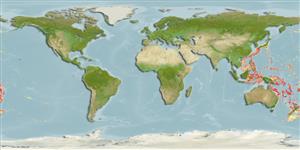>
Gadiformes (Cods) >
Macrouridae (Grenadiers or rattails)
Etymology: Hymenocephalus: Named for its transparent membrane-like head covering (‘‘hymen head’’) and fragile nature of head bones (Ref. 100825).
More on authors: Gilbert & Hubbs.
Environment: milieu / climate zone / depth range / distribution range
Écologie
marin benthopélagique; profondeur 366 - 1000 m (Ref. 35908). Deep-water
Western Central Pacific: South China Sea off Hong Kong, through Philippines and Indonesia, off northern Australia, to New Caledonia and New Zealand.
Taille / Poids / Âge
Maturity: Lm ? range ? - ? cm
Max length : 18.2 cm TL mâle / non sexé; (Ref. 97189)
Description synthétique
Morphologie | Morphométrie
Épines dorsales (Total): 2. This species is distinguished by the following characters: pelvic rays usually 12-14 (elsewhere 11-13); total gill-rakers first arch (outer/inner) 17-22/23-28, second arch 22-28/22-26; no chin barbel; snout length 22-31% HL; orbit diameter 29-40% HL; suborbital width 10-14%HL, interorbital width 24-29%HL; most of the orbit, upper surface of snout, sides of head and trunk silvery or pale, ventral aspects of heed and trunk black; a prominent midlateral stripe of silvery (when fresh) or brownish (preserved) pigment running along trunk and tail (Ref. 97189). Additional distinguishing characteristics: pectoral fin rays 13-16; projecting snout, 20-26% HL; infraorbital width 11-16% HL; moderately long preopercular supporter, with obtuse angle at rear margin, 4-9% HL; ventral striae reaching to ½ distance from pelvic fin bases to periproct; otolith has moderately high predorsal lobe, with colliculi separated, closely placed across collum with a tendency to joining in large individuals, terminating at some distance from anterior and posterior rims of otolith; otolith length to height (OL:OH), 1.1-1.2; total colliculum length to pseudocolliculum length (TCL:PCL), 1.8-2.4 (Ref. 98298).
A benthic species found on the continental slope (Ref. 75154). Maximum depth from Ref. 106682.
Life cycle and mating behavior
Maturité | Reproduction | Frai | Œufs | Fécondité | Larves
Iwamoto, T. and N.R. Merrett, 1997. Pisces Gadiformes: Taxonomy of grenadiers of the New Caledonian region, southwest Pacific. Mem. Mus. Natl. Hist. Nat. (176):473-570. (Ref. 35908)
Statut dans la liste rouge de l'IUCN (Ref. 130435)
Menace pour l'homme
Harmless
Utilisations par l'homme
Plus d'informations
Noms communsSynonymesMétabolismePrédateursÉcotoxicologieReproductionMaturitéFraiRassemblement de ponteFéconditéŒufsDéveloppement de l'œuf
Taille/ÂgeCroissanceLongueur-poidsLongueur-longueurFréquences de longueursMorphométrieMorphologieLarvesDynamique des populations larvairesRecrutementAbondanceBRUVS
RéférencesAquacultureProfil d'aquacultureSouchesGénétiqueElectrophoresesHéritabilitéPathologiesTraitementNutrientsMass conversion
CollaborateursImagesStamps, Coins Misc.SonsCiguateraVitesseType de nageSurface branchialeOtolithesCerveauxVision
Outils
Articles particuliers
Télécharger en XML
Sources Internet
Estimates based on models
Preferred temperature (Ref.
123201): 6.4 - 11.4, mean 8.2 °C (based on 237 cells).
Phylogenetic diversity index (Ref.
82804): PD
50 = 0.5000 [Uniqueness, from 0.5 = low to 2.0 = high].
Bayesian length-weight: a=0.00219 (0.00111 - 0.00431), b=3.20 (3.03 - 3.37), in cm total length, based on LWR estimates for this (Sub)family-body shape (Ref.
93245).
Niveau trophique (Ref.
69278): 3.3 ±0.4 se; based on size and trophs of closest relatives
Résilience (Ref.
120179): Milieu, temps minimum de doublement de population : 1,4 à 4,4 années (Preliminary K or Fecundity.).
Fishing Vulnerability (Ref.
59153): Low vulnerability (10 of 100).
